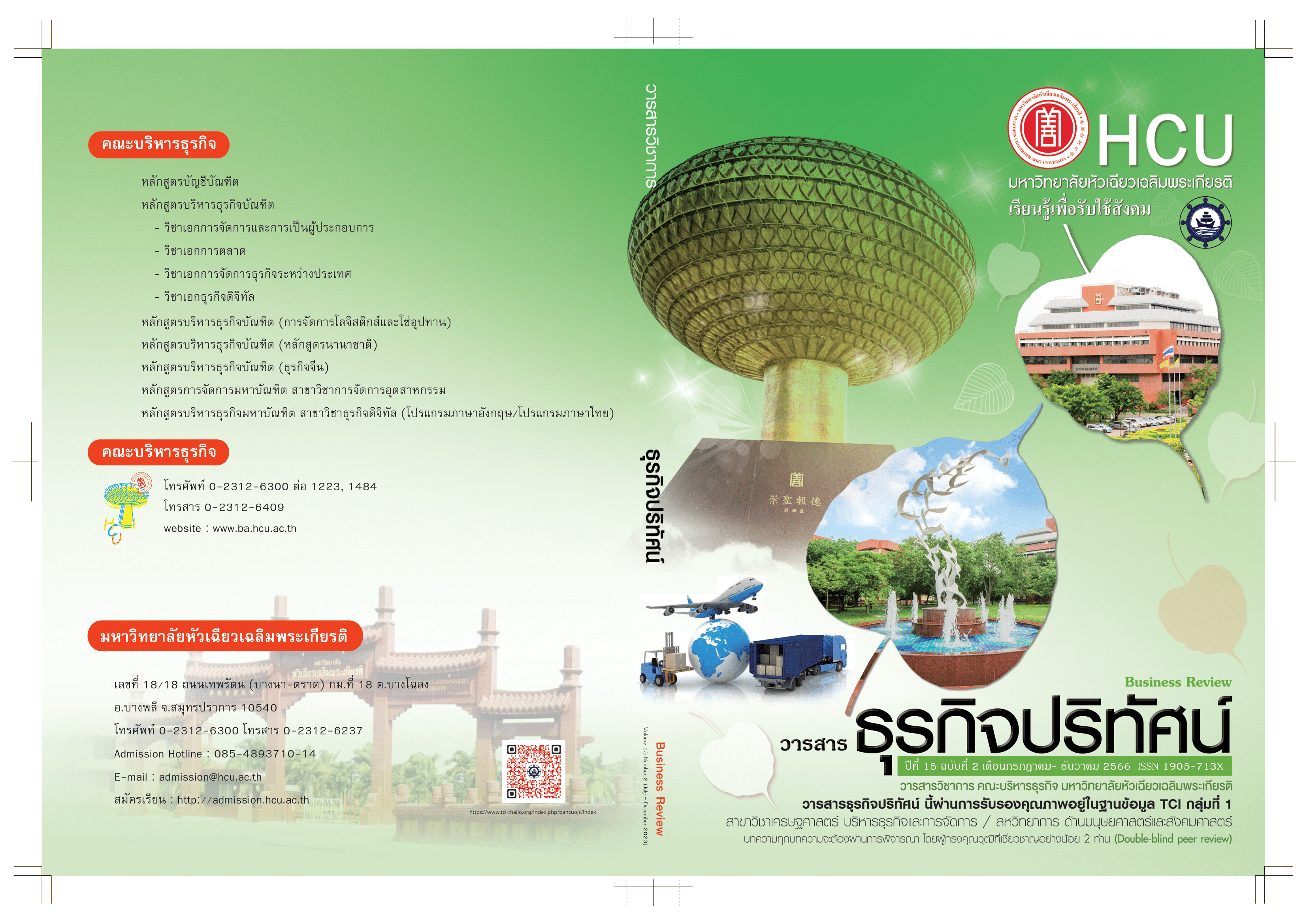Roadmap for Achieving Rapid Development of The Circular Economy in China
Keywords:
Circular Economy Development, People Republic of China, Roadmap, Challenges and OpportunitiesAbstract
This article describes China's circular economy growth. The circular economy gathers and analyzes pertinent data, including the primary plan for enhancing the national economy and addressing China's social development. Government policies, particularly the ongoing expansion of the logistics sector, are what motivate the creation of a sustainable image and the promotion of ethical principles to convey to people, communities, and nations the advantages of maintaining the environment. Includes techniques for collecting garbage at home China is making strides in its circular economy growth, but there are still challenges and constraints that the nation must overcome in order to pursue its goal of resource sustainability. These lessons will serve as a roadmap for creating and understanding Thailand's circular economy growth plan in accordance with the national development plan, which will inspire and motivate everyone.
References
เลิศลักษณ์ เจริญสมบัติ. (2564). การประยุกต์ใช้แนวคิดระบบเศรษฐกิจหมุนเวียนกับวิสาหกิจชุมชน. วารสารสังคมศาสตร์ มหาวิทยาลัยศรีนครินทรวิโรฒ, 24(1), 145-155.
สถานเอกอัครราชทูต ณ กรุงปักกิ่ง. (2564). ส่องแผนพัฒนาเศรษฐกิจหมุนเวียนใหม่ของจีน สู่เป้าหมายเศรษฐกิจสีเขียว. สืบค้นเมื่อ 9 เมษายน 2566, เว็บไซต์: http://eastasiawatch.mfa.go.th/th/articles/social-and-environmental-issues/1094/?sphrase_id=21134278
สํานักงานเศรษฐกิจอุตสาหกรรม. (2563). แนวทางการพัฒนาอุตสาหกรรมไทยตามแนวคิดเศรษฐกิจหมุนเวียน (Circular Economy). สืบค้นเมื่อ 9 เมษายน 2566, เว็บไซต์: https://www.oie.go.th/assets/portals/1/files/study_report/DevelopThaiIndustries_CircularEconomy.pdf.
สถาบันเทคโนโลยีและสารสนเทศเพื่อการพัฒนาที่ยั่งยืน. (2565). กิจกรรม “Food waste กับแนวคิดเศรษฐกิจหมุนเวียน”. สืบค้นเมื่อ 9 เมษายน 2566, เว็บไซต์: https://www.nstda.or.th/nac/2022/wp-content/uploads/2022/04/food-waste-02.pdf
อักษรศรี พานิชสาส์น. (2560). แผนพัฒนา 5 ปี ฉบับที่ 13 ของจีน: นัยต่อไทย. วารสารเอเชียปริทัศน์, 38(1), 53-58.
อักษรศรี พานิชสาส์น. (2562). The Rise of China: จีนคิดใหญ่ มองไกล (พิมพ์ครั้งที่ 1). สํานักพิมพ์กรุงเทพฯ : ซีเอ็ดยูเคชั่น.
Bleischwitz, R., Yang, M., Huang, B., Xiaozhen, X. U., Zhou, J., McDowall, W., ... & Yong, G. (2022). The circular economy in China: Achievements, challenges, and potential implications for decarbonization. Resources, Conservation and Recycling, 183, 106350.
Bao, Z., & Lu, W. (2020). Developing efficient circularity for construction and demolition waste management in fast emerging economies: Lessons learned from Shenzhen, China. Science of the Total Environment, 724, 138264.
Dong, H., Geng, Y., Yu, X., & Li, J. (2018). Uncovering energy saving and carbon reduction potential from recycling wastes: A case of Shanghai in China. Journal of Cleaner Production, 205, 27-35.
Ellen MacArthur Foundation. (2020). What is the circular economy? Retrieved March 28, 2023, from
https://www.ellenmacarthurfoundation.org/circular-economy/what-is-the-circular-economy.
Feng, K., & Lam, C. Y. (2021). An overview of circular economy in China: How the current challenges shape the plans for the future. The Chinese Economy, 54(5), 355-371.
Huang, B., Yong, G., Zhao, J., Domenech, T., Liu, Z., Chiu, S. F., ... & Yao, Y. (2019). Review of the development of China's Eco-industrial Park standard system. Resources, Conservation and Recycling, 140, 137-144.
Liu, W., Wang, S., Lin, Y., Xie, D., & Zhang, J. (2020). Effect of intelligent logistics policy on shareholder value: evidence from Chinese logistics companies. Transportation Research Part E: Logistics and Transportation Review, 137, 101928.
Liu, Y., Zhu, Q., & Seuring, S. (2020). New technologies in operations and supply chains: Implications for sustainability. International journal of production economics, 229, 107-889.
Mordor Intelligence. (2023). CHINA WASTE MANAGEMENT MARKET - GROWTH, TRENDS, COVID-19 IMPACT, AND FORECASTS (2023 - 2028). Retrieved March 28, 2023, from: https://www.mordorintelligence.com/industry-reports/china-waste-management-market
Ogunmakinde, O. E. (2019). A review of circular economy development models in China, Germany, and Japan. Recycling, 4(3), 27.
United Nations (2020). Population. Retrieved March 28, 2023, from: https://www.un.org/en/sections/issuesdepth/population/.
Wang, N., Guo, J., Zhang, X., Zhang, J., Li, Z., Meng, F., ... & Ren, X. (2021). The circular economy transformation in industrial parks: Theoretical reframing of the resource and environment matrix. Resources, Conservation and Recycling, 167, 105251.
World Bank. (2019). Enhancing China’s Regulatory Framework for Eco-Industrial Parks: Comparative Analysis of Chinese and International Green Standards.
World Bank. (2022). Circular Economy Key to Supporting Thailand’s Resilient Recovery amidst Rising Global Risks. Retrieved March 28, 2023, from:
Zhang, Y., Chao, Y., Fan, R., Ren, F., Qi, B., Ji, K., & Xu, B. (2021). Spatial-temporal trends of rainfall erosivity and its implication for sustainable agriculture in the Wei River Basin of China. Agricultural Water Management, 245, 106-557.
Zhu, J., Fan, C., Shi, H., & Shi, L. (2019). Efforts for a circular economy in China: A comprehensive review of policies. Journal of industrial ecology, 23(1), 110-118.
Downloads
Published
How to Cite
Issue
Section
License
Copyright (c) 2023 Business Review Journal

This work is licensed under a Creative Commons Attribution-NonCommercial-NoDerivatives 4.0 International License.
All articles published in the Business Administration and Management Journal Review are copyrighted by the journal.
The views and opinions expressed in each article are solely those of the individual authors and do not represent those of Huachiew Chalermprakiet University or any other faculty members. Each author is fully responsible for the content of their own article. Any errors or issues found are the sole responsibility of the respective author.




